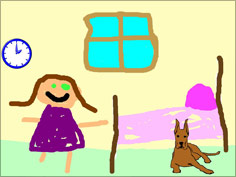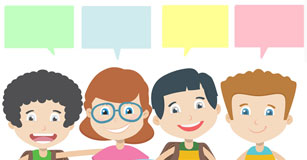Language Limitations and Presentations of Learning
Make presentations of learning work for ELLs and primary students

I have been thinking a lot about the power of presentations of learning lately. I strongly believe that we miss a huge opportunity when students simply display slideshows of work they have produced. We need to add in feedback and reflection about the product and process.
However, this is more difficult for younger students and second language learners who are just growing into literacy. How do these students articulate their learning without being constrained by language limitations?
Celebrating the results of hard work is a positive experience every student should enjoy, not fear. Following are a few ways to ensure this opportunity is available for young students and ELLs.
James Asher, the developer of the Total Physical Response model of language learning, has postulated that language is learned primarily by listening. As students present multimedia projects that include a combination of text, images, and either recorded narration or live oral presentations to support slideshow content, students in the audience hear language supported by images and other media that that help them decode and remember, and they see textual representations of the words they are hearing.
Asher, and many other researchers in the field of language acquisition, has also claimed that learning language should not involve any stress. Even students with strong language skills are unlikely to agree that oral presentations in any form in front of an audience are stress free; the stress is compounded for ELLs. How can we overcome the stress associated with this form of communication?
Set Norms for Presentations
Classrooms that have a positive culture celebrate risk taking and practice. This environment isn’t always easy to cultivate, but it can be fostered by directly talking about norms for communication, discussion, and presentations.
Talk to your students about appropriate behaviors for presentations. Establish presentation procedures so that when students are done presenting products and ideas, the audience applauds to celebrate. Next, open the floor for positive comments from the audience. Once the audience has positively reinforced the speaker, have the audience ask any questions about the material covered.
To keep the culture positive as everyone is learning, you may want to keep presentations by primary learners and those made by ELLs completely free of critiques.
Use Voice Recordings Instead of Oral Presentations
Tools like Pixie and Wixie allow students to record narration. Instead of dealing with the stress of speaking live in front of a large group, English language learners and struggling readers can instead record their comments using a microphone and headphones. Carolyn Daly describes this process as a “private, non-threatening opportunity to practice fluency.” Recording their narration affords students the ability to read, reread, record, listen, and rerecord. Once students feel positive about the results of their narration, they can share it with others.
If you don’t have the necessary hardware for recording audio, encourage ELLs to read the text they have on the screen or memorize the sentences, practicing fluency and building confidence before presenting to the class.
Provide Presentation Sentence Starters
To reduce anxiety about speaking improperly in front of the class, provide sentence starters to students before they present. For example:
“Hello, my name is ________. I am here to teach you about ________.”
“On my page, I made a ________. (noun) It is _____ (adjective).”
“My favorite thing on my page is __________.”
“I learned that ____________.” (fact)
“It is important to know _________ about ________ .” (fact about subject).
Model the process in front of students using the sentence starters you provide. The modeling process also provides you with an opportunity to refine the sentence starters to make them more naturally. Changing a sentence to make it better is a wonderful example of risk taking for your students, allowing you to show that you are also learning and that learning English isn’t always easy.
Use Student Presentation Materials for Other Class Activities
You can also support language acquisition and vocabulary building by using the contents on a slide as part of a class discussion or activity. Share a slide or choose a page in a presentation and ask the class to name the objects that they see. For example, in this image, students might share words like girl, bed, sister, window, dog, and clock.

Then, have students brainstorm adjectives to describe the objects, like large, small, green, rectangle, old, and so on. Write the words where everyone can see so that students associate the written words with their pronunciation. Using work students have done as part of a larger project also demonstrates that you value their efforts and contributions.
In Summary
In the words of Stephen Krashen, students best acquire language
“the way thousands of people have acquired second languages throughout history... They acquired second languages while they were focused on something else, while they were gaining interesting or needed information, or interacting with people they liked to be with.”
No matter how you choose to celebrate student work and structure presentations of learning, be sure to make the process fun and non-threatening so students share and produce language without even realizing that they are also practicing literacy.
















